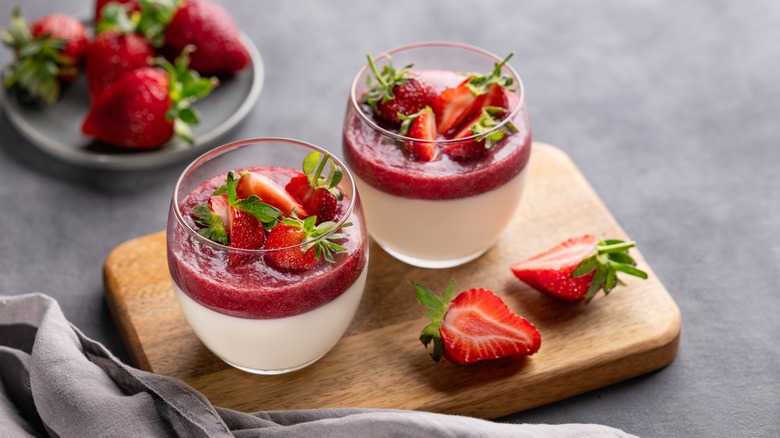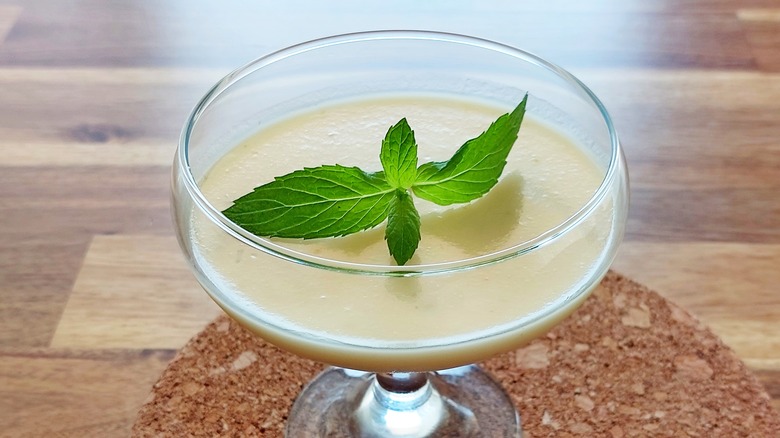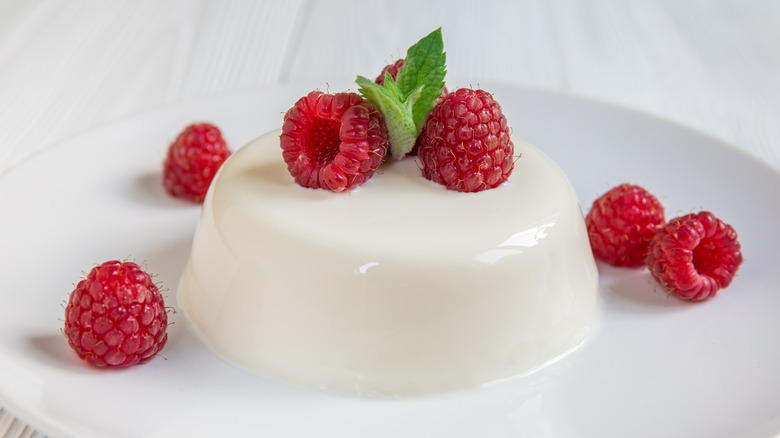What Makes Lemon Posset Different From Panna Cotta?
Desserts appeal not only through scrumptious sweetness, but by way of textures, too. Whether it's a custardy crème brûlée (perhaps creatively stuffed inside a sweet potato), smooth ice cream, or a slice of silky chocolate cake, attaining that perfect consistency defines a dish. Especially in the case of creamy creations like lemon posset and panna cotta, pinpointing their distinctions will enhance your knowledge of various sweet treats and their textures.
Hailing from Britain, lemon posset marries cream, sugar, and citrus juice to create a luscious consistency that's a tad thicker than a mousse. Only citric acid is used to solidify the dish, with an overnight rest coagulating the milk proteins together. It's a tasty treat that features clean, bright flavors.
On the other hand, Italian-born panna cotta combines a mixture of milk, cream, sugar, and flavorings with gelatin, which firms the dessert into a creamy pudding-like creation. Airy yet sturdy, this dessert is a bit more custardy than a posset, but should melt in the mouth upon each bite. Although typically flavored with vanilla, panna cotta is a vessel for many flavors, making it more a versatile vehicle for other ingredients than lemon posset. Nevertheless, there's appeal to both desserts, with each offering a distinct take on airy creaminess.
Tangy lemon posset sets cream with acid
At its core, lemon posset is a straightforward creamy creation, employing an acid-based thickening technique similar to yogurt. In fact, you can even think of it like a slightly denser, fruitier sour cream substitute, simply redressed into dessert form. Curiously, the dish emerged from a medicinal background in Britain, first employing sweet alcohol, rather than citrus, to set the curd-like mixture. Often used alongside different starchy stabilizers, the aim was to thicken the dish without curdling it.
Once citrus arrived in England, the dessert took on a more refined form. Lemons specifically became favored not only due to their bright flavor, but higher acidity — an orange won't coagulate cream as well, although it can be combined with more sour citrus. From such a combination, modern posset emerged, prioritizing a clean fruity taste and a smooth texture. Today, chefs experiment with additions like lime or passion fruit, crafting newly flavored interpretations. Note that posset's delicate, acid-dependent texture isn't conducive to all fruits, though, so it's made in a more limited range of flavors compared to panna cotta.
As a result, lemon posset is frequently a component in other desserts, like the filling in a tart or different types of cheesecake. It's also frequently served with biscuits, berries, ice cream, or whipped cream for additional texture. So, as opposed to panna cotta's more standalone nature, think of lemon posset as a smooth and brightly flavored foundation for grander sweet treats.
Panna cotta employs gelatin to thicken milk and cream
Panna cotta appears all around Europe, but its strongest ties are with the northern Piedmont region of Italy. An area famous for its high-quality dairy and cheese production, panna cotta took hold as a quick-to-create dessert. Translating to cooked cream, milk and cream are heated, flavored, and sweetened, then combined with gelatin to set the creamy Jell-O-like treat.
As opposed to lemon posset, panna cotta's use of gelatin allows for better stability, hence a wider range of flavor integration. In addition to the common vanilla flavor, everything from fruit and chocolate to spices and syrups can be infused into the custard. Plus, there's opportunity to use different milks, like buttermilk, goat, or even a lactose-free, plant-based milk. Just take note that gelatin is made from animal products, so the dessert poses an issue for vegetarians. However, there are a few available substitutes.
Also, due to the gelatin, panna cotta doesn't require much time to set. Although it's important to briefly bloom the gelatin when combining it with the warmed milk and cream mixture, the dessert can be chilled and ready to eat in as short as three hours. It'll reach the firmest possible consistency after 12 hours, though. Typically, it's served with some fresh berries, caramel, or fruit or chocolate sauce on top — its texture is more conducive to being a standalone dish than lemon posset. Such qualities make it a more popular dessert option, although there's appeal to posset's tangy creaminess, too.


